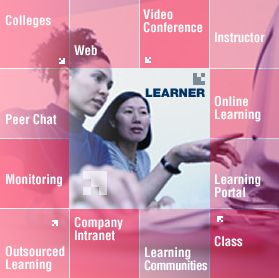
 |

Hanlun eLearning can also be used in a traditional learning environment, for example, in a university. In this scenario, the advantages of eLearning, such as individualized learning, can be combined with the strengths of the instructor that substantially increase student achievement.
| Learner-Centric | |||||||||||||||||||
| eLearning enables a learner-centric, rather than teacher-centric, environment for learners. Through the appropriate use of learning, multimedia, and network technologies, students can now access to much previously unavailable content, learning tools, and services. In the future, instructor is likely to act as a facilitator in the students' construction of their own knowledge. | |||||||||||||||||||
| Learning Technologies | |||||||||||||||||||
| The foundation of eLearning is based on the principles self-learning, meaning that instead of being taught, students are encouraged to engage in self-learning activities at their own pace and according to their own needs, without the confinement of a classroom setting. | |||||||||||||||||||
| Multimedia Technologies | |||||||||||||||||||
|
The benefits of using multimedia technologies are plenty. In our application, most often, they can be viewed as features to improve the delivery of instructional content and the ability to create an immediate, interactive, and engaging environment for students to learn. When designing and developing our eLearning content, we use multimedia technologies extensively to:
|
|||||||||||||||||||
| Network Technologies | |||||||||||||||||||
|
The Internet is revolutionizing the way education is delivered. Internet and network technologies allow people to learn anytime, anywhere and anyhow. Network technology provides a framework for both asynchronous and synchronous communication for students and instructors. Students construct their knowledge by formulating their ideas through discussion, debate, real-time communication etc on the platform network technology provides. Research has shown that by employing a fix of asynchronous and synchronous communication and collaboration among students and instructors, for formal and informal discussion, can increase the efficiency of learning and teaching. |
|||||||||||||||||||
| Characteristics of eLearning | |||||||||||||||||||
|
|||||||||||||||||||